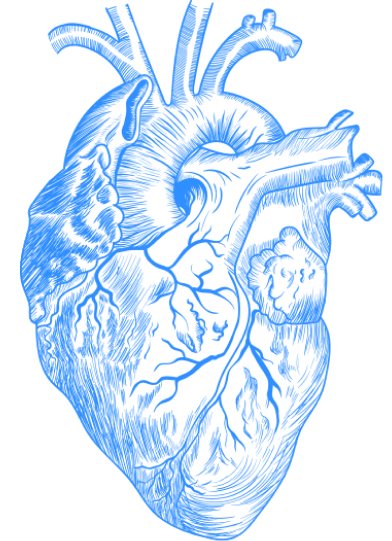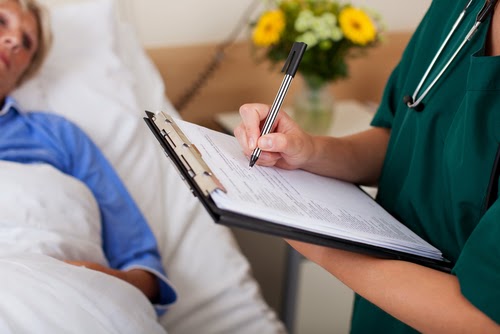
My editors here at The New Atlantis suggested I write about what a day is like for me and other members of the medical team. What exactly (aside from rounding) do we do all day? When do we have to be in? When do we leave? What goes on when we’re not rounding?
We can divide the third year of medical school into three distinct categories of rotations. There are inpatient weeks (hospital work), outpatient weeks (doctor’s office work), and the Emergency Department, or ED. The roles differ as do the schedules. I have already described a bit about how the ED works here. The hospital is for patients who need urgent medical attention or medical procedures. If a patient is having a heart attack, for instance, a cardiologist in the hospital will make sure the patient does not suffer complications from the disease process. Outpatient work, by contrast, involves less urgent medical problems, like adjusting blood pressure medications or prescribing antibiotics for an ear infection. Let me take you through a day on inpatient and outpatient medicine.
Inpatient
On an inpatient service the interns arrive at approximately 6 a.m. or, if on a surgical service, at 5:30 a.m., and print out a patient list from the electronic health record. This list of patients contains the patient names, chief complaints, possible diagnoses, ages, and other basic information of the patients we need to see. It contains a summary of tests and test results as well. It may seem a bit silly that physicians need a reminder about which patients they are taking care of; however, the hospital experiences quick turnover. A patient may be present for only a couple of days before leaving. Then, a new patient with a new history and a new problem takes his or her place. Additionally, when there are sixteen patients on the list it is difficult to keep up with every story.
Medical students arrive shortly after the interns (the residents are a bit like our supervisors, letting us know when we can leave and when we ought to come in). Given how early in the day we usually have to be in, there is little time in the morning to do anything but eat a quick breakfast while bleary-eyed before driving to the hospital in the dark. If we’re there early enough, we receive checkout from the night intern. The night intern goes through each patient on the list and discusses the latest news on each patient. Did the patient vomit? Did he or she have trouble breathing? What interventions, tests, or treatments were done? Additionally, if the night intern admitted new patients overnight, what is the story behind the hospital admission? These questions are vital to the care of each patient. If the day resident does not know, for example, that a patient was having trouble breathing or received an imaging study then the resident does not know to look at the results of that study, potentially missing a life-threatening problem like a collapsed lung or a heart attack. In an ideal world, the transition between resident shifts is so seamless that it is as if the day resident took care of or admitted patients during the night.
Subsequently, the interns assign medical students to “follow” one, two, or three patients (depending on how far along we are during our third year). Following a patient means knowing the vital signs daily and keeping up with the results of x-rays, CT scans, and lab tests. It also means we come up with a plan for that patient’s care and propose it to the attending and residents. In truth, the residents and attendings already know what they are going to do for the patient and our proposals are merely an exercise for our own edification.
After these assignments, we go through the chart on the electronic health record and read about the patient’s history. We read the night intern’s note on the patient and we look at the labs (tests) that the intern ordered. These notes give us a sense of what the residents or attendings thought the patient had and needed. For example, if the patient came into the ED with a fever and a cough, the notes will usually mention a workup and treatment for a possible pneumonia, or lung infection (which includes a chest x-ray, sputum culture, and empiric antibiotics). More importantly, students and residents look at the vital signs of the patients we follow. These indicate if the patient needs immediate treatment. Is the blood pressure too low with a fast heart rate and a high body temperature? This indicates a possible blood infection and we take blood cultures and administer antibiotics.
Despite the fact that the sun has not yet peeked through the hospital windows, we subsequently visit patients in their rooms to do a physical exam. We look at new rashes that patients have, listen to hearts and lungs with stethoscopes and perform neurological exams. We target our exam at the patient’s presenting illness. For a patient with pneumonia, we listen closely to the patient’s lungs for abnormal breathing sounds due to the infection. All this, of course, entails waking the patient up. And since residents, appropriately, will come in after us to make sure that we have done the physical exam correctly and that the patient is in no distress, we unfortunately wake the patient up at least twice during the early morning hours. This is separate from the instances where the nurses wake the patient up to draw blood for morning labs. Such is one difficulty of being a patient at a teaching hospital, something I will discuss in future posts.
 |
| Image via Shutterstock |
Once we’re finished seeing the patients, we have a little bit of time left before rounds start at 8 a.m. We look up information about the illnesses our patients have. We also write down the information we will need to present the patient to the attending physician on rounds. I’ve written a bit about patient presentations in this post, but in sum, our presentations report the relevant medical information and treatment plan in an organized and concise matter.
At 8 a.m., the attending arrives and we round on patients. Aside from the few patient presentation(s) we do for the attending we remain silent and watch and learn as I’ve described previously. Once we finish rounding we go over the patient list in the physician work room. We make sure that we all agree on the plans for each patient for the rest of the day. Some patients need to leave the hospital. Some need more IV fluids or medications. And some need an imaging study or a blood test.
After we’ve confirmed all of this, the residents write “notes” about each patient for the electronic health record. A note is similar in format to a patient presentation. It contains a brief history of the patient’s chief complaint and illness as well as the blood test results, imaging test results, diagnosis, past medical history, and past surgical history, as well as the treatment plan for the patient. These notes, though incredibly time-consuming, serve a valuable purpose. First, legally, the note can help protect a physician from future lawsuits. The note documents a physician’s train of thought and actions. It justifies the tests and treatments which patients receive in the hospital. Second, it is used for billing purposes by documenting what was done for the patient. And third, when the patient goes for a follow-up appointment with another physician in clinic, the note acts as a standardized form of communication to update the clinician on what was done in the hospital.
At lunchtime, medical students usually receive a lecture from a physician in the rotation. In pediatrics, for instance, we may listen to a lecture on pediatric respiratory complaints from a pediatrician. Meanwhile, the residents remain in the workroom or, if they’ve finished with their notes, they can grab a quick bite to eat in the cafeteria. Sometimes, though, the residents are swamped. They carry around pagers or phones, and nurses and other physicians page or call throughout the day with questions about specific patients. A patient may get a headache or feel nauseous and the nurse may page the resident to ask if it’s okay to give pain medication or antiemetics (medication for nausea or vomiting). Given that there are a limited number of residents, if multiple patients fall extremely ill and need medications, it can be difficult for the residents to respond to other more minor complaints. A cardiac arrest on the floor, for example, may prevent the resident from ordering pain medication for a patient with a headache.
More on a day in the life, in a bit…

